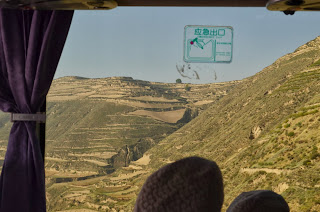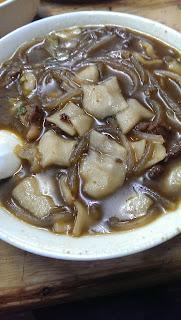Before we went to Dunhuang, we stopped again in Linxia and Lanzhou (as we had to take a train in Lanzhou). In Linxia, we had the famous beef noodles (niu rou la mian) and visited a mosque.
Can I just be a food photographer? That would be an awesome job.
From architecture...
... to incense...
... to silk...
... to art.
Here's a bridge!
We took the train overnight from Lanzhou to Dunhuang. This one was a hard sleeper. The cots are a bit smaller and less comfortable (I found out later that the middle and top ones are so short that you can't sit up) and there are no doors. I was a bit worried, but it was absolutely no big deal. Soft sleeper isn't really worth the extra money.
Yeah, I took this one on my phone. Sorry about that.
It looks exactly like what it is: A little train station in a little desert town.
We arrived the next morning in Dunhuang. It was the first outdoor train station I saw (other than outside my window), and it looked so much like the kind you see in movies or in certain black-and-white Oscar-winning animated short films.
Something about Dunhuang struck me as American. It was about the size of an American city (reminded me a little bit of Tulsa but smaller), and the buildings sometimes had space between them and weren't built very high.
I've never seen giant dunes outside my window in America, though.
The paintings are delicate, so the grottoes will actually be closing some time next year, as visitors damage them just by breathing.
The gardens were beautiful as well. Here stand the
Prophets of Feipanism: Daniel and Joey. (Yeah, we founded a religion during our trip. Who doesn't?)
We went to dinner by the Night Market. It was a really interesting experience. There was this courtyard full of tables with men and women urging you to sit down. You would order from their menu (every couple of tables had a different owner), and they would run around the market buying you food.
Emily and Mary (the other Alliance bloggers!) and Daniel
Elizabeth, Joey, and Allison
Lena and Shelby
Donkey meat (on the plate with the cilantro) and some rather tasty noodles.
Donkey meat is famous in Dunhuang. Unfortunately, another group of students ate at a different table and got donkey meat from a different restaurant. It appeared to make them sick, although that's awfully quick work for food poisoning!
There was this really cool stage with light-up ads behind it (which you can see in one of my pictures), and I made the mistake of mentioning out loud how cool it would look if someone were to go up there and dance.
Emily loves to push me into doing things, and this time she had Joey to help her.
Yep.
After my little adventure, we decided to walk around the Dunhuang Night Market.
So pretty.
Typical fare.
There were a lot of people who did crafts like wood carving. One guy in particular caught our eye.
He was kind enough to let me take his picture.
He hand-painted the inside of glass bottles using a traditional painting style. His work was exceptionally beautiful.
The next day, we went to see the Gobi Desert.
These trees are tough. Not only do they live in the desert, but they also live for a thousand years.
And then take another thousand to fall.
And then another thousand to break.
This is the Jade Gate - a famous pass along the Silk Road.
The original Great Wall, built way before the famous one! It's from the Ming Dynasty.
That night was a real adventure.
We rode camels!
Look at us. Look at those dunes.
We rode the camels to the dunes and then scrambled up. Once we got to the top, we scrambled up even higher, up to a peak. It was quite the struggle because the sand was so soft.
You know me. Have to dance everywhere.
... Even if the sand disagrees!
One of my favorite pictures from the trip.
Sun setting over the dunes.
Running back down. See where we left the camels?
The next day was our last in Dunhuang. We packed up and checked out, and then we went to our guide (Wangjie)'s in-law's family farm.
Cotton is a major industry in Dunhuang.
Picturesque
We helped pick cotton; they made the most delicious lunch. Oh man were we spoiled.
Picking cotton was surprisingly satisfying.
At this point, I was feeling a bit ill, which prompts me to give you all a piece of advice that seems obvious:
When you're in dry climates, drink a lot of water! I fell a little bit behind, and boy, did I regret it.
Stay tuned for Part III, the final chapter in the great journey!





















































